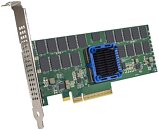- Joined
- Oct 9, 2007
- Messages
- 47,684 (7.42/day)
- Location
- Dublin, Ireland
| System Name | RBMK-1000 |
|---|---|
| Processor | AMD Ryzen 7 5700G |
| Motherboard | Gigabyte B550 AORUS Elite V2 |
| Cooling | DeepCool Gammax L240 V2 |
| Memory | 2x 16GB DDR4-3200 |
| Video Card(s) | Galax RTX 4070 Ti EX |
| Storage | Samsung 990 1TB |
| Display(s) | BenQ 1440p 60 Hz 27-inch |
| Case | Corsair Carbide 100R |
| Audio Device(s) | ASUS SupremeFX S1220A |
| Power Supply | Cooler Master MWE Gold 650W |
| Mouse | ASUS ROG Strix Impact |
| Keyboard | Gamdias Hermes E2 |
| Software | Windows 11 Pro |
SMART Modular Technologies, Inc., a subsidiary of SMART Global Holdings, Inc., (NASDAQ: SGH), and a leader in specialty memory, storage and hybrid solutions including memory modules, Flash memory cards and other solid state storage products, today announced that it has begun shipping its nvNITRO Accelerator Card featuring MRAM technology. SMART has partnered with Everspin Technologies, Inc. (NASDAQ: MRAM), the world's leading developer and manufacturer of discrete and embedded magnetoresistive random access memory (MRAM), to launch the new Spin-transfer Torque MRAM (STT-MRAM)-based nvNITRO Accelerator Card. The nvNITRO is ideally suited for the most demanding transaction logging applications and, along with enhanced performance features, is designed with plug-and-play capability requiring no changes to system hardware, memory reference, bios or file systems.
MRAM technology is byte-addressable and persistent with very low latency, enabling dramatically improved system performance for many applications. The nvNITRO Accelerator Card fully exploits these unique attributes to provide a disruptive solution for industries where transaction processing and data recording performance are critical. For example, nvNITRO can reduce financial application wait times by reducing latency up to 90% over enterprise SSDs. Based on this performance data, SMART and Everspin will jointly target customers in the financial sector including joint demonstrations of nvNITRO performance at The Trading Show in Chicago, May 9-10.

The nvNITRO card enables a system application to write or log large amounts of data at the full performance of incoming data and provides extremely low and highly consistent read latencies of under 10µs. This enables a customer to utilize a single nvNITRO card as a front end cache connected to less expensive backend storage devices, providing a very cost effective solution for logging information and accessing terabytes of data at very high performance, while providing power loss protection for data. No super capacitors, UPS or batteries are required because nvNITRO is power fail safe through its use of STT-MRAM persistent memory technology.
The nvNITRO Accelerator Card is currently available in a half-height half-length (HHHL) PCIe Gen3 form factor which is NVM Express 1.2.1 compliant. Available in a 1GB density, the card supports greater than 1.5 million IOPS and approximately 6μs latency based on 4K random read/write. Evaluation samples are available and can be obtained by contacting SMART.
For more information, visit the product page.
View at TechPowerUp Main Site
MRAM technology is byte-addressable and persistent with very low latency, enabling dramatically improved system performance for many applications. The nvNITRO Accelerator Card fully exploits these unique attributes to provide a disruptive solution for industries where transaction processing and data recording performance are critical. For example, nvNITRO can reduce financial application wait times by reducing latency up to 90% over enterprise SSDs. Based on this performance data, SMART and Everspin will jointly target customers in the financial sector including joint demonstrations of nvNITRO performance at The Trading Show in Chicago, May 9-10.

The nvNITRO card enables a system application to write or log large amounts of data at the full performance of incoming data and provides extremely low and highly consistent read latencies of under 10µs. This enables a customer to utilize a single nvNITRO card as a front end cache connected to less expensive backend storage devices, providing a very cost effective solution for logging information and accessing terabytes of data at very high performance, while providing power loss protection for data. No super capacitors, UPS or batteries are required because nvNITRO is power fail safe through its use of STT-MRAM persistent memory technology.
The nvNITRO Accelerator Card is currently available in a half-height half-length (HHHL) PCIe Gen3 form factor which is NVM Express 1.2.1 compliant. Available in a 1GB density, the card supports greater than 1.5 million IOPS and approximately 6μs latency based on 4K random read/write. Evaluation samples are available and can be obtained by contacting SMART.
For more information, visit the product page.
View at TechPowerUp Main Site




